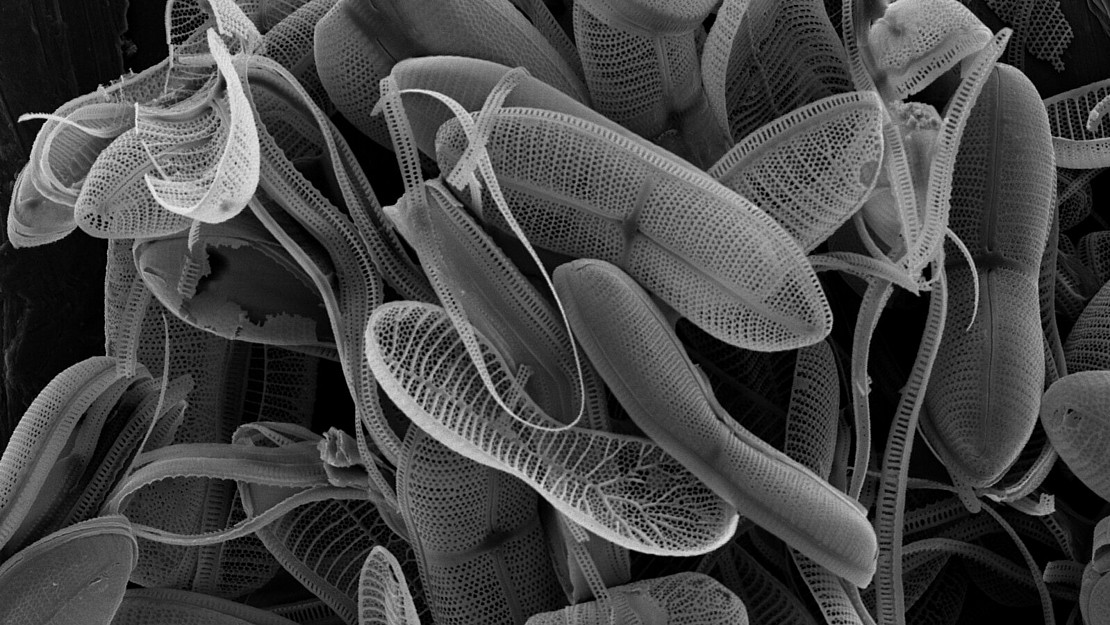This page contains automatically translated content.
A cuckoo clock mechanism regulates the reproduction of diatoms
 Image: Jonas Ziebarth.
Image: Jonas Ziebarth.Unicellular diatoms have a unique life cycle that lasts for thousands of generations: Their population size and the average size of individual cells constantly oscillate between two extremes, as evidenced by surveys in lakes. Reproduction by cell division produces daughter cells, each smaller than the original cell - until the last generation of cells is so small that it can no longer divide. Then the population moves on to sexual reproduction. The fusion of two germ cells that then occurs creates larger initial cells again. Thus, the cycle begins anew, the so-called multigenerational clock is reset.
However, according to this system, based on mathematical principles (the so-called MacDonald-Pfitzer scheme), the population dynamics of diatoms would inevitably come to a halt over time: Both average cell and population size would level off at a constant value. In reality, however, this is not the case. Now, however, nanoscientists and mathematicians at the University of Kassel have been able to identify two clocks that prevent the cycle from coming to a standstill by systematically extending the underlying mathematical model. "Thus, the biological clock of diatoms resembles the pendulum of a cuckoo clock that has to be wound up from time to time," describes Prof. Fuhrmann-Lieker, leader of the research project.
"First, we assume that the diatom cells created by sexual reproduction lose any information about the age of the population. The multigenerational clock is then set to zero in our model," Prof. Fuhrmann-Lieker said. This aging model, he said, most closely matches the biology of the cells. This condition keeps the cycle going for tens of thousands of generations. Only then does it move toward a state of equilibrium. "So we can assume that the population dynamics of diatoms remain stable over millions of generations," adds nanoscientist Jonas Ziebarth.
In reality, however, no biological system remains undisturbed for that long. This leads to the second, external clock: the natural environment. Any external disturbance, such as periodic changes in light conditions, temperature and the availability of nutrients over the seasons, or the appearance of predators, affects the reproductive behavior of diatoms. For example, the population responds to a high food supply with increased cell division and thus greater growth. However, this is enough to give the system new momentum, and the oscillation begins anew.
"We see typical accumulating effects here: The reproduction of diatoms on a nanoscale with an internal timer influences the entire population dynamics and, at the base of the food pyramid, ultimately also the natural carbon cycle," emphasizes Prof. Fuhrmann-Lieker. Diatoms produce a significant fraction of the oxygen in the atmosphere and sequester 20-25% of the total carbon on Earth. Although diatoms are tiny single-celled organisms, these models of their population dynamics enable us to better understand even complex global ecosystems.
In the future, the research results will be experimentally verified in the new DFG Research Training Group "Multiscale Clocks" at the University of Kassel. In particular, the scientists of the collegium investigate the synchronization of different fast timers in cells.
Contact:
apl. Prof. Dr. Thomas Fuhrmann-Lieker
Department 10 - Natural Sciences & Mathematics
Institute of Chemistry
Phone: +49 561 804-4795
E-mail: th.fuhrmann[at]uni-kassel[dot]de
Press contact:
Sebastian Mense
University of Kassel
Communications, Press and Public Relations
Phone 0561 804-1961
E-mail: presse [at]uni-kassel[dot]de